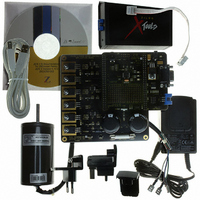Z8FMC160100KITG Zilog, Z8FMC160100KITG Datasheet - Page 180

Z8FMC160100KITG
Manufacturer Part Number
Z8FMC160100KITG
Description
KIT DEV FOR Z8 ENCORE Z8FMC16100
Manufacturer
Zilog
Series
Z8 Encore! MC™r
Datasheets
1.Z8FMC160100KIT.pdf
(7 pages)
2.Z8FMC160100KIT.pdf
(383 pages)
3.Z8FMC160100KITG.pdf
(2 pages)
4.Z8FMC160100KITG.pdf
(15 pages)
Specifications of Z8FMC160100KITG
Main Purpose
Power Management, Motor Control
Embedded
Yes, MCU, 8-Bit
Utilized Ic / Part
Z8FMC16100
Primary Attributes
3-Ph DC Motors
Secondary Attributes
Graphical User Interface
For Use With
269-4664 - KIT ACC OPTO-ISO USB SMART CABLE269-4661 - KIT ACC ETHERNET SMART CABLE269-4539 - KIT ACCESSORY USB SMART CABLE
Lead Free Status / RoHS Status
Lead free / RoHS Compliant
Other names
269-4660
- Z8FMC160100KIT PDF datasheet
- Z8FMC160100KIT PDF datasheet #2
- Z8FMC160100KITG PDF datasheet #3
- Z8FMC160100KITG PDF datasheet #4
- Current page: 180 of 383
- Download datasheet (5Mb)
PS024613-0910
Master Arbitration
If a master loses arbitration during the address byte, it releases the SDA line, switches to
SLAVE mode and monitors the address to determine if it is selected as a slave. If a master
loses arbitration during the transmission of a data byte, it releases the SDA line and waits
for the next
The master detects a loss of arbitration when a 1 is transmitted but a 0 is received from the
bus in the same bit-time. This loss occurs if more than one master is simultaneously
accessing the bus. Loss of arbitration can occur during the address phase (two or more
masters accessing different slaves) or during the data phase, when the masters are attempt-
ing to write different data to the same slave.
When a master loses arbitration, the software is informed by means of the Arbitration Lost
interrupt. The software can repeat the same transaction at a later time.
A special case can occur when a slave transaction starts just before the software attempts
to start a new master transaction by setting the
enters its slave states before the
arbitrate. If a slave address match occurs and the I
START
minimize the chance of this instance occurring by checking the
register before initiating a master transaction. If a slave address match does not occur, the
Arbitration Lost interrupt will not occur, and the
controller will initiate the master transaction after the I
Master Address-Only Transactions
It is sometimes preferable to perform an address-only transaction to determine if a particu-
lar slave device is able to respond. This transaction can be performed by monitoring the
ACKV
ister and the
register determines if the slave is able to communicate. The
I2CCTL register to terminate the transaction without transferring data. For a
10-bit slave address, if the first address byte is acknowledged, the second address byte
should also be sent to determine if the preferred slave is responding.
Another approach is to set both the
After both bits have cleared (7-bit address has been sent and transaction is complete), the
ACK
STOP
being sent).
Master Transaction Diagrams
In the following transaction diagrams, the shaded regions indicate the data that is
transferred from the master to the slave, and the unshaded regions indicate the data that is
transferred from the slave to the master.
bit can be read to determine if the slave has acknowledged. For a 10-bit slave, set the
bit in the I2CSTATE register after the address has been written to the I2CDATA reg-
bit after the second TDRE interrupt (which indicates that the second address byte is
bit is cleared and an Arbitration Lost interrupt is asserted. The software can
STOP
START
or
bit has been set. After the
START
condition.
START
STOP
bit is set, and as a result, the I
and
ACKV
START
START
2
START
C controller receives/transmits data, the
bit is set, the
Z8FMC16100 Series Flash MCU
2
bit. In this case, the state machine
C bus is no longer busy.
bits (for sending a 7-bit address).
bit will not be cleared. The I
STOP
BUSY
Product Specification
ACK
bit must be set in the
2
bit in the I2CSTATE
bit in the I2CSTATE
C controller will not
Master Transactions
2
C
168
Related parts for Z8FMC160100KITG
Image
Part Number
Description
Manufacturer
Datasheet
Request
R

Part Number:
Description:
Communication Controllers, ZILOG INTELLIGENT PERIPHERAL CONTROLLER (ZIP)
Manufacturer:
Zilog, Inc.
Datasheet:

Part Number:
Description:
KIT DEV FOR Z8 ENCORE 16K TO 64K
Manufacturer:
Zilog
Datasheet:

Part Number:
Description:
KIT DEV Z8 ENCORE XP 28-PIN
Manufacturer:
Zilog
Datasheet:

Part Number:
Description:
DEV KIT FOR Z8 ENCORE 8K/4K
Manufacturer:
Zilog
Datasheet:

Part Number:
Description:
KIT DEV Z8 ENCORE XP 28-PIN
Manufacturer:
Zilog
Datasheet:

Part Number:
Description:
DEV KIT FOR Z8 ENCORE 4K TO 8K
Manufacturer:
Zilog
Datasheet:

Part Number:
Description:
CMOS Z8 microcontroller. ROM 16 Kbytes, RAM 256 bytes, speed 16 MHz, 32 lines I/O, 3.0V to 5.5V
Manufacturer:
Zilog, Inc.
Datasheet:

Part Number:
Description:
Low-cost microcontroller. 512 bytes ROM, 61 bytes RAM, 8 MHz
Manufacturer:
Zilog, Inc.
Datasheet:

Part Number:
Description:
Z8 4K OTP Microcontroller
Manufacturer:
Zilog, Inc.
Datasheet:

Part Number:
Description:
CMOS SUPER8 ROMLESS MCU
Manufacturer:
Zilog, Inc.
Datasheet:

Part Number:
Description:
SL1866 CMOSZ8 OTP Microcontroller
Manufacturer:
Zilog, Inc.
Datasheet:

Part Number:
Description:
SL1866 CMOSZ8 OTP Microcontroller
Manufacturer:
Zilog, Inc.
Datasheet:

Part Number:
Description:
OTP (KB) = 1, RAM = 125, Speed = 12, I/O = 14, 8-bit Timers = 2, Comm Interfaces Other Features = Por, LV Protect, Voltage = 4.5-5.5V
Manufacturer:
Zilog, Inc.
Datasheet:

Part Number:
Description:
Manufacturer:
Zilog, Inc.
Datasheet:










